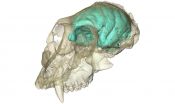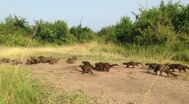(Press-News.org) BARCELONA-LUGANO, 4 July 2015 - Patients with metastatic colorectal cancer (mCRC) that are mutation-free in the KRAS, NRAS, BRAF and PIK3CA genes showed significant benefit from continuing anti-epidermal growth factor receptor (EGFR) therapy beyond progression following first-line chemotherapy and an anti-EGFR monoclonal antibody, according to study results (1) presented today at the ESMO 17th World Congress on Gastrointestinal Cancer in Barcelona, Spain.
Prof Fortunato Ciardiello from Seconda Università degli Studi di Napoli, Italy, presented results from the CAPRI-Goim study on the efficacy of cetuximab plus FOLFOX chemotherapy as second-line treatment for patients with mCRC that progressed following FOLFIRI chemotherapy and cetuximab.
CAPRI-GOIM is a non-profit, academic, phase II trial enrolling 340 patients with mCRC and KRAS exon 2 wild-type tumours, according to local molecular pathology laboratory assessment. All patients received standard first-line treatment of FOLFIRI plus cetuximab until disease progression or unacceptable toxicity, as previously reported (Ciardiello et al, Annals of Oncology 2014).
Following first-line treatment, patients experiencing disease progression were randomised 1:1 to receive second-line treatment of FOLFOX plus cetuximab (Arm A; n= 74) or sole FOLFOX (Arm B; n=79). The primary endpoint of the study was progression-free survival (PFS) and secondary endpoints were overall survival (OS), response rate and safety.
"We are presenting final results for PFS, response rate and OS from the second part of the CAPRI study, which evaluated the so-called 'beyond progression' concept," Ciardiello said.
Analysis of these data in the overall intent to treat population showed an advantage in PFS favouring arm A that did not reach statistical significance; Median PFS was 6.4 months in the FOLFOX plus cetuximab arm A compared to 4.5 months in the FOLFOX arm B (hazard ratio [HR] 0.81; 95% CI 0.58, 1.12; log-rank test, p = 0.19).
"We therefore looked for patient characteristics that would account for this result; next generation sequencing (NGS) of the genes of interest was performed on the archival tissue samples from the patients' primary tumours," explained Ciardiello.
The investigators used the Ion AmpliSeqTM Colon and Lung cancer panel, comprising 500 hotspot mutations in 22 genes, and Ion Reporter™ Software, as previously described (Ciardiello et al, Annals of Oncology 2014; Normanno et al., Annals of Oncology 2015). NGS was possible in 117 (76.5%) patients and revealed that 66 patients had "all RAS" wild-type tumours with no mutations in KRAS; NRAS; BRAF; or PIK3CA genes and 51 patients had tumours harbouring a mutation in at least one of these genes. KRAS exon 2 mutations were found in approximately 15% of the tumours that were originally identified as wild-type.
Two distinct patient populations detected
"The most important thing we found was that when we considered patients regarding the KRAS, NRAS, BRAF and PIK3CA genes we could have two patient populations: one that was multiple wild-type and normal for all 4 genes and another of patients that were mutated in at least one of these genes. In the patients with at least one mutation in one of these genes, there was a detrimental effect from FOLFOX plus cetuximab in progression-free survival, response rate and overall survival," Ciardiello commented.
Whereas the mutation free, quadruple wild-type population showed significantly prolonged PFS, and improved OS and response rates with second-line cetuximab/FOLFOX, this treatment had the opposite effect upon patients with genetic mutations in the EGFR pathway. Cetuximab/FOLFOX demonstrated significantly longer PFS in patients with quadruple wild-type tumours, while the median PFS in arm A was nearly half that of arm B shorter in patients with a mutation in any of the 4 EGFR-dependant genes.
Second-line FOLFOX plus cetuximab is feasible past progression in patients with metastatic colorectal cancer and an EGFR-dependant tumour
"An Important finding from this study is those patients with tumours which were multiple wild type --that means no mutation in the KRAS, NRAS, BRAF and PIK3CA genes, were most likely to be EGFR-dependent; in fact, these patients had significantly better progression-free survival when treated with cetuximab and chemotherapy than when treated with chemotherapy alone, hazard ratio 0.56, which was significant (p = 0.025). Response rate was also improved, as was overall survival, HR 0.57 (p = 0.056)," said Ciardiello.
Prof Andrés Cervantes, Biomedical Research Institute, INCLIVA, University of Valencia, Spain, ESMO spokesperson, not involved in the study, commented: "This is a new understanding of how to treat a select group of patients that are wild-type for the KRAS, NRAS, BRAF and PIK3CA genes who can be treated with the same anti-EGFR antibody and a change in chemotherapy following progression. In the intent to treat analysis there is no benefit from this treatment, however the patients showing no mutation do benefit from this approach."
"This is a new finding, that these patients can have an advantage from re-challenge with the same antibody," Cervantes remarked.
Conclusions
"CAPRI is the first study to evaluate cetuximab as second line beyond progression in patients with metastatic colorectal cancer in a randomised phase 2 study. Results suggest tumours with multiple wild-type KRAS, NRAS, BRAF and PIK3CA genes are likely to benefit from chemotherapy plus cetuximab and to demonstrate significantly better progression-free survival, response rate and overall survival than with chemotherapy alone," commented Ciardiello.
Ciardiello continued: "A word of caution; these results generate a very important signal that deserves to be further explored in a larger, randomised, phase 3 study, that continuing anti-EGFR treatment while switching the chemotherapy backbone in second line is feasible past progression and by identifying patients whose tumour is EGFR dependent; that by identifying wild-type status for KRAS, NRAS, BRAF and PIK3CA genes, also identifies patients responsive to this treatment."
INFORMATION:
References
1 Abstract LBA-09 "Cetuximab beyond progression in RAS wild type (WT) metastatic colorectal cancer (mCRC): the CAPRI-GOIM randomized phase II study of FOLFOX versus FOLFOX plus cetuximab" will be presented by Fortunato Ciardiello during Session XIX: Metastatic Colorectal cancer on Saturday 4 July, 11:50.
Mice that are exposed to the powerful smell of cat urine early in life do not escape from cats later in life. Researchers at the A. N. Severtsov Institute of Ecology and Evolution, Russia, have discovered that mice that smell cat urine early in life, do not avoid the same odour, and therefore do not escape from their feline predators, later in life.
"Because the young mice (less than 2 weeks-old) are being fed milk while being exposed to the odour, they experience positive reinforcement," says Dr Vera Voznessenskaya, one of the lead researchers behind this study. "So ...
To mark the final day of the 65th Lindau Nobel Laureate Meeting, on Friday, 3 July, over 30 Nobel laureates assembled on Mainau Island on Lake Constance signed a declaration on climate change. The "Mainau Declaration 2015 on Climate Change" states "that the nations of the world must take the opportunity at the United Nations Climate Change Conference in Paris in December 2015 to take decisive action to limit future global emissions." It is expected that a new international agreement on climate protection will be approved at the 21st UN Climate Conference to succeed the ...
DURHAM, N.C. -- The brain hidden inside the oldest known Old World monkey skull has been visualized for the first time. The creature's tiny but remarkably wrinkled brain supports the idea that brain complexity can evolve before brain size in the primate family tree.
The ancient monkey, known scientifically as Victoriapithecus, first made headlines in 1997 when its fossilized skull was discovered on an island in Kenya's Lake Victoria, where it lived 15 million years ago.
Now, thanks to high-resolution X-ray imaging, researchers have peered inside its cranial cavity ...
BARCELONA-LUGANO, 3 July 2015 - The phase IIIb CONSIGN study has confirmed the benefit of regorafenib in patients with previously treated metastatic colorectal cancer (mCRC), researchers announced at the ESMO 17th World Congress on Gastrointestinal Cancer 2015 in Barcelona.(1) The safety profile and progression free survival were similar to phase III trial results.
CONSIGN was a prospective, observational study that was initiated to allow patients with mCRC access to regorafenib before marketing authorisation and to assess safety, which was the primary endpoint. The randomised ...
Spiders travel across water like ships, using their legs as sails and their silk as an anchor, according to research published in the open access journal BMC Evolutionary Biology. The study helps explain how spiders are able to migrate across vast distances and why they are quick to colonise new areas.
Common spiders are frequently observed to fly using a technique called 'ballooning'. This involves using their silk to catch the wind which then lifts them up into the air. Ballooning spiders are estimated to move up to 30 km per day when wind conditions are suitable, helping ...
Scientists have developed a new technique allowing the bioprinting at ambient temperatures of a strong paste similar to 'play dough' capable of incorporating protein-releasing microspheres.
The scientists demonstrated that the bioprinted material, in the form of a micro-particle paste capable of being injected via a syringe, could sustain stresses and strains similar to cancellous bone - the 'spongy' bone tissue typically found at the end of long bones.
This work, published today (3 July 2015) in the journal Biofabrication, suggests that bioprinting at ambient temperatures ...
A therapy that replaces the faulty gene responsible for cystic fibrosis in patients' lungs has produced encouraging results in a major UK trial.
One hundred and thirty six patients aged 12 and over received monthly doses of either the therapy or the placebo for one year.
The clinical trial reached its primary endpoint with patients who received therapy having a significant, if modest benefit in lung function compared with those receiving a placebo.
Patients from across England and Scotland participated, and were treated in two centres, Royal Brompton Hospital in ...
Banded mongooses take extraordinary risks to ensure that they find the right mate.
Female banded mongooses risk their lives to mate with rivals during pack 'warfare' and both males and females have also learned to discriminate between relatives and non-relatives to avoid inbreeding even when mating within their own social group.
Researchers from the University of Exeter and Liverpool John Moores University found that 18% of wild banded mongoose pups are fathered by males from rival packs.
Banded mongooses are found living in stable social groups across Central ...
For the first time gene therapy for cystic fibrosis has shown a significant benefit in lung function compared with placebo, in a phase 2 randomised trial published in The Lancet Respiratory Medicine journal. The technique replaces the defective gene response for cystic fibrosis by using inhaled molecules of DNA to deliver a normal working copy of the gene to lung cells.
"Patients who received the gene therapy showed a significant, if modest, benefit in tests of lung function compared with the placebo group and there were no safety concerns," said senior author Professor ...
LAWRENCE -- A new study that is the first to use Social Security Administration's personal income tax data tracking the same individuals over 20 years to measure individual lifetime earnings has confirmed significant long-term economic benefits of college education.
ChangHwan Kim, a University of Kansas researcher, said the research team was also able to account for shortcomings in previous studies by including factors such as gender, race, ethnicity, place of birth and high school performance that would influence a person's lifetime earnings and the probability of college ...




